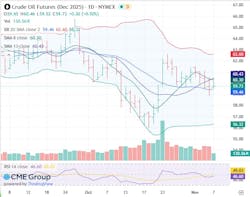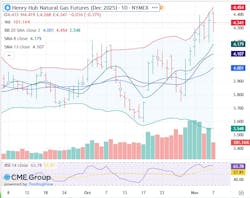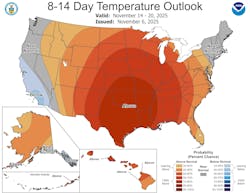Oil, fundamental analysis
Crude prices entered a $2.00/bbl range-bound consolidation period last week which continued into this week. Such price boundaries signify indecision on the part of traders due to varying market signals. The OPEC+ output increase was baked-in to the market ahead of the official meeting, but future plans were not known until Sunday. A US/China trade deal was announced but scant details were released. And the weekly inventory report held an unexpected surprise.
WTI prices had their weekly high of $61.50/bbl on Monday but fell to a low of $58.85 by Thursday. Brent followed a similar pattern, hitting its high of $65.30/bbl on Monday with its weekly low of $62.85 on Thursday. Both grades settled lower vs. last week by about -$1.50/bl. The WTI/Brent spread has tightened to ($4.08).
The OPEC+ group made its 117,000 b/d output increase for December official this past Sunday. However, it also announced an unexpected pause in further increases. OPEC has always been 'bullish' on future oil demand vs. other market analyses such as the International Energy Agency (IEA). This may be signaling a different take on the supply/demand balance.
Saudi Arabia, the largest oil producer of the group, just lowered its price for sales to Asia to the lowest level in 11 months. Traders appear to be in agreement as futures prices are still in a backwardated pattern whereby the near month is trading higher than 'out' months indicating a view that future demand will be less.
Reinforcing the uncertainty in the market is the fact that futures prices for WTI, the US grade, are in a range of $59.20 to $59.70 for the next 12 months with $60.00/bbl not seen until September 2027.
The IEA continues to forecast an oil surplus and recently cited a 102 million bbl water-bourn supply in September which the agency says is the largest increase since the pandemic. Goldman Sachs analysts also agree with the IEA’s assumptions and are bearish on oil prices in the near term.
On a more bullish note, Wood Mackenzie contends that global demand for oil will continue to increase at least until 2032 as the goals of the Paris Accord are not being met.
Ukraine continues its assault on Russian oil infrastructure with the latest attack hitting a Lukoil refinery, one of Russia’s largest refined product hubs. The sanctioned oil company was reported to have reached a deal with Gunvor to sell certain assets which Gunvor has now declined to pursue.
China has amassed over +1.0 billion in oil reserves through the first 9 months of the year. As one of Russia’s largest markets, China has both provided themselves with a cushion should the latest round of sanctions actually impact Russian exports, while at the same time providing the market some underlying support.
The Energy Information Administration’s (EIA) Weekly Petroleum Status Report (still released despite the government shut-down) indicated that commercial crude oil inventories for last week increased by 5.2 million bbl while production remained near 13.6 million b/d vs. 13.5 last year. The Strategic Petroleum Reserve (SPR) was up 500,000 bbl to 409.6 million bbl.
Oil, technical analysis
December 2025 WTI NYMEX futures are trading around their 8-, 10- and 20-day Moving Averages this week. Volume Friday is below the recent average at 130,000. The Relative Strength Indicator (RSI), a momentum indicator, stayed in neutral territory at 47. Resistance is now pegged at $60.45 (8-day MA) while near-term critical Support is $60.00.
Looking ahead
Oil markets will be monitoring the impact of the latest round of sanctions on Russian oil with an eye towards India to see if there will be a significant drop in their imports. The OPEC+ decision to hold off on output increases from January on should provide some price support.
A cold front is moving down from Canada into the Upper-Midwest which, while bullish for natural gas, that region is not a large consumer of heating oil like the Northeast. Further out, temperatures are forecasted to moderate.
Unrest between Israel and Hamas had reversed any hopes for a peaceful settlement despite the recent agreement to a ceasefire. The US equity markets have been volatile of late due to both the government shut down and market perceptions of tech stocks.
Demand for energy commodities such as oil are directly tied to the future outlook for the US and global economies.
Natural gas, fundamental analysis
December NYMEX natural gas futures got a boost this week on an emerging cold front and strong LNG exports. A modest storage injection was near expectations but did manage to raise the season-ending volume to over 3.9 tcf. The week’s High was $4.42/MMbtu on Friday while the week’s Low was $4.09 on Monday.
Supply/demand data was not available this week due to the shutdown. However, LNG export volumes remain at slightly above the 16.0 bcfd level. In the UK, natural gas prices at the NBP were most recently $10.65/MMbtu on a par with Dutch TTF while Asia’s JKM was quoted at $11.15/MMbtu.
The EIA’s Weekly Natural Gas Storage Report indicated an injection of 33 bcf, above the forecasted +31 bcf. Total gas in storage is now 3.915 tcf, now 0.2% below last year and 4.3% above the 5-year average. We did achieve a season-ending volume of 3.9 tcf but with the small injection last week, it would be highly unlikely to increase storage to 4.0 tcf prior to cold weather withdrawals occurring.
Natural gas, technical analysis
December 2025 NYMEX Henry Hub Natural Gas futures stair-stepped higher this week and continued to move past their 8-, 13- & 20-day Moving Averages. Volume was 105, lower than recent averages. The RSI has moved into overbought territory at 64 on this week’s rally. Support is $4.20 (8-day MA) with key Resistance at $4.45 (Upper-Bollinger Band).
Looking ahead
The prospects for colder weather need to materialize in the heavily populated regions of the US but the 8–14-day outlook does not indicate such. That could lead to an end to the natural gas rally. Technical selling could also begin. At 3.9 tcf, we enter the winter heating season with adequate reserves and on a par with last year’s volume. The official hurricane season ends at the end of the month and those storms have not been a factor for natural gas markets this year.
About the Author

Tom Seng
Dr. Tom Seng is an Assistant Professor of Professional Practice in Energy at the Ralph Lowe Energy Institute, Neeley School of Business, Texas Christian University, in Fort Worth, Tex.


